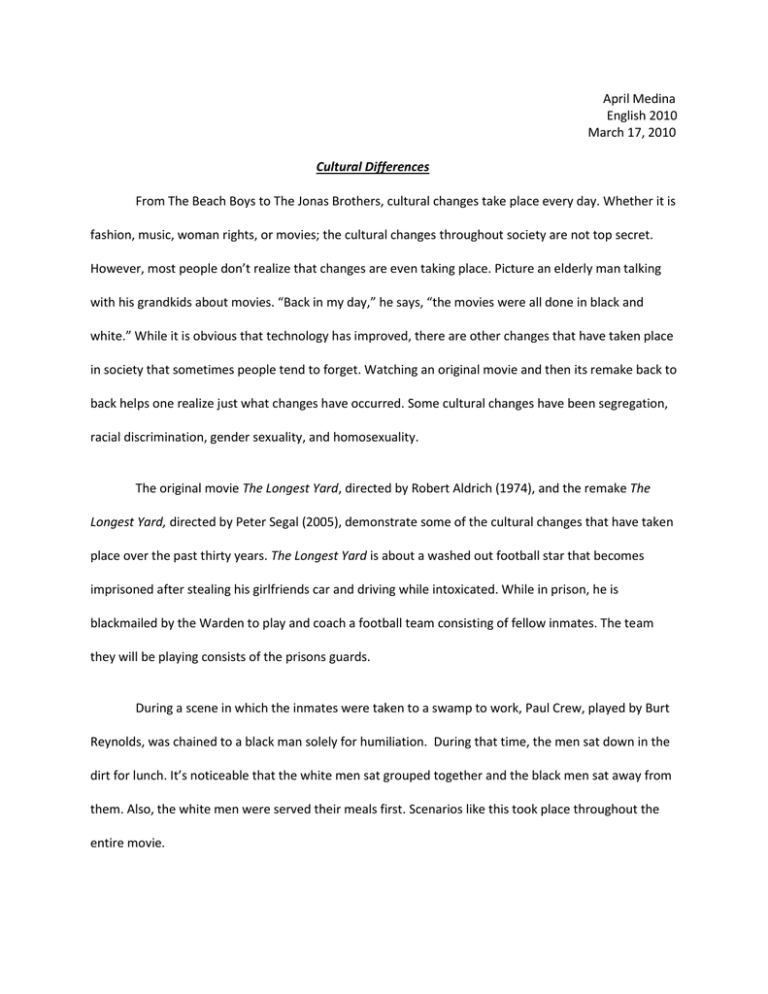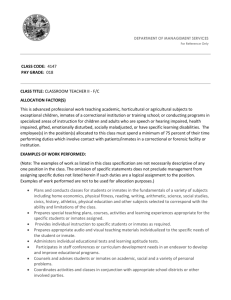April Medina English 2010 March 17, 2010 Cultural Differences
advertisement

April Medina English 2010 March 17, 2010 Cultural Differences From The Beach Boys to The Jonas Brothers, cultural changes take place every day. Whether it is fashion, music, woman rights, or movies; the cultural changes throughout society are not top secret. However, most people don’t realize that changes are even taking place. Picture an elderly man talking with his grandkids about movies. “Back in my day,” he says, “the movies were all done in black and white.” While it is obvious that technology has improved, there are other changes that have taken place in society that sometimes people tend to forget. Watching an original movie and then its remake back to back helps one realize just what changes have occurred. Some cultural changes have been segregation, racial discrimination, gender sexuality, and homosexuality. The original movie The Longest Yard, directed by Robert Aldrich (1974), and the remake The Longest Yard, directed by Peter Segal (2005), demonstrate some of the cultural changes that have taken place over the past thirty years. The Longest Yard is about a washed out football star that becomes imprisoned after stealing his girlfriends car and driving while intoxicated. While in prison, he is blackmailed by the Warden to play and coach a football team consisting of fellow inmates. The team they will be playing consists of the prisons guards. During a scene in which the inmates were taken to a swamp to work, Paul Crew, played by Burt Reynolds, was chained to a black man solely for humiliation. During that time, the men sat down in the dirt for lunch. It’s noticeable that the white men sat grouped together and the black men sat away from them. Also, the white men were served their meals first. Scenarios like this took place throughout the entire movie. Another example of segregation throughout the movie is in the bunk houses. There were only white men. The black men had separate housing. According to Steve Yeater of USA Today, “although Brown v. Education changed our educational system in 1968, the beginning of the fourteenth amendment opened up many doors pertaining to equal rights and desegregation.” Desegregation laws had only been in effect four years prior to the making of the original The Longest Yard leaving racial segregation and discrimination still a societal norm. In the newer version of The Longest Yard, Paul Crew, played by Adam Sandler, is befriended by a black inmate named “Caretaker”. Caretaker is played by Chris Rock, an African American actor/comedian. They become friends and allies in the beginning of crews incarceration. Caretaker becomes Crews right hand man and manager of the inmate football team. By 2005, it had been more than 37 years since Brown v. Education. Segregation and discrimination are no longer a societal norm and both are prosecutable by law. “Since the landmark Brown v. Board of Education ruling, the court has repeatedly held that racial segregation is unacceptable, including a 1968 decision barring blanket segregation in prisons. However, prison officials are generally free in managing their facilities, to control violence and protect inmates and those who guard them” (Yeater). Although desegregation laws are in place one must underand that our nations prisons abide by their own rules. Prison segragation is necessary for protecting inmates from rival gangs. In the 1974 The Longest Yard, segregation was still a cultural norm, however, today it is not acceptable but still occurs, just for different reasons. It happening is no longer racial discrimination but it is racial safety for the inmates. “Frances Grunder, the state's senior assistant attorney general, told the court as she defended temporary segregation of inmates. There is an unwritten California policy, dating back more than 25 years, requiring officials to assign newly arrived black prisoners to bunk only with other black prisoners for two months or more. Inmates are separated again by race when they transfer to a new facility. Similar inmate segregation is also used in Texas and Oklahoma. California has more than 165,000 inmates and violence can erupt if white and black gang members are mixed” (Yeater). There have been many cultural changes in the past 30 years. Another example of cultural changes that have taken place is the acceptance of homosexuality. According to Bruce Rind, writer for the “Journal of Sex Research”, “a quarter of a century ago the courts considered homosexuality as ‘loathsome and disgusting’. In psychiatry, homosexuality was termed as ‘a dread dysfunction.’” He also states that by the 1970’s, “ in the wake of gay liberation and the women's movement, man-man sex became more tolerated in liberal circles, was depathologized by the American Psychiatric Association, and became increasingly decriminalized.” As a result, society began accepting homosexuality causing another cultural transformation. In the remake of The Longest Yard, some of the male inmates are openly gay and become cheerleaders for the football team made up of inmates. Throughout the movie, these men speak in a feminine manner to allow viewers to distinguish the difference in their sexuality. They also make flirtatious comments to the other male inmates who pass them off as a joke. The openly gay men make themselves known throughout the entire movie. The gay cheerleaders cheer at the practices held in the prison yard as well as the game. In the original movie, however, there isn’t any talk or implication of any homosexuality until the tail end of the movie. During the big game between the inmates and the guards, there are cheerleaders who put on their show directly in front of the fans. They are presented as women, wearing sequenced shirts and sparkly gold shorts. The only indication that these cheerleaders are indeed men, are their husky male voices belting out applause for their friends. It isn’t until the last minute of the movie that one of the cheerleaders removes the wig from his head, showing the audience his true gender. Anyone with a quick eye can see he is really a man. The clip is short, perhaps a mere five seconds rather than throughout the movie as in the remake. Another significant cultural change is the way women have been seen by men. In the original The Longest Yard, character Paul Crew has a girlfriend whose only role is to be the sexy, seductive, whiney girlfriend, whom he shoves to the floor by her face when trying to leave. Crew, however, is the hot stud of a football player and his character implies that women are merely sex object that haven’t any say in what goes on with her man. In the newer version of The Longest Yard, Crews girlfriend, played by Cortney Cox, is educated, sophistacted, and of course, she is fully clothed. In fact, she refers to Crew as her “boy toy” and preceeds to badger him into attending a party she is hosting so that she can show him off to her friends. Rather than push her to the floor, like in the original, Crew coherces her into the closet where he casually locks the door behind her. He then jumps in her expensive car and leaves their residence. Why the change from 1974 to 2005? Women have been fighting for equal rights for hundreds of years. Society has been exploiting the sexuality of women although equal right laws have been in place for decades. As the oppressed majority in the United States, women have been fighting hard for equality in employment, government, their homes, and their sexuality. According to Patricia Ireland, President of National Organization for Women and the author of What Women Want, states that, “the 14th ammendment [states] that ‘persons’ have equal rights to laws, and that the 15th ammendment gave men, not women the right to vote. By 1920, the 50 year campaign ended with the 19th ammendment, which completed the 15th ammendment, allowing women the right to vote, but leaving the 14th ammendment ‘as-is’.” “In 1982, state legislators denied ratification of the Equal Rights Amendment within the ten-year time limit cynically imposed by Congress. Legislators resisted constitutional equality for women for real, not "symbolic" reasons--it would have invalidated men's power to use sex discrimination selectively when it is to their advantage to do so in the making, interpreting, and enforcing of law. This legal power is not acknowledged in history or law books, but that does not mean that men are unaware of it. In 1983, for example, Justice Lewis Powell asked an attorney arguing a racial discrimination case before the Supreme Court if his arguments applied to sex as well. ‘No,’ the lawyer assured him, ‘We didn't fight a Civil War over sex discrimination, and we didn't pass a constitutional amendment against it.’ Not one of the nine justices disagreed with this” (Ireland). Jill Filipovic, writer and a lawyer based in New York City states, “Beauty pageants like the Miss USA contest are a reflection of a culture in which women are not equal. In particular, women's bodies are not their own but are seen as objects of beauty for others. This perception of women's function and value in society is reflected in beauty pageants, but it did not arise from them. Beauty pageants will go away once the oppression of women and misogyny in larger society is eliminated.” As time moves forward, there will be many more changes in our future. Perhaps every ‘persons’, as it states in the 14th amendment will one day truly have equal rights and women will no longer be the oppressed majority within our society. Will they ever stop being seen as sex objects? Probably not to the fullest, but with baby steps taking place, women are making headway. It’s possible that gender roles could reverse in the future and men will be the sex objects. Perhaps they will be the ones walking down runways in tight nearly bare bikinis. A friend recently told me, “For all those men who say why marry the cow when you can get the milk for free? Here’s an update for you! Nowadays, 80% of women are against marriage, why? Because women realize it's not worth buying an entire pig just for a little sausage!” Ireland, Patricia. "Women's rights." Social Policy 28.3 (1998): 14-16. Academic Search Premier. EBSCO. Web. 17 Mar. 2010 Jill Filipovic. "Beauty Pageants Show That Women Still Have Not Achieved Equality." At Issue: Beauty Pageants. Ed. Noël Merino. Detroit: Greenhaven Press, 2010. Opposing Viewpoints Resource Center. Gale. UALC Salt Lake Community College. 19 Mar. 2010 Rind, Bruce. "Biased Use of Cross-Cultural and Historical Perspectives on Male Homosexuality in Human Sexuality Textbooks." Journal of Sex Research 35.4 (1998): 397-407. Academic Search Premier. EBSCO. Web. 18 Mar. 2010 Steve Yeater, AP. USA Today . 4 November 2004.Web. 17 March 2010 <http://www.usatoday.com/news/washington/2004-11-02-prison-racial-segration_x.htm>.






